There's only three articles which I'll link at the bottom as sources. No timetables of S11 nor S13, but maps in the 1990s by Mike Harris contain the route. No photos of buses at all. Only one photo of P15, with a few timetables archived.
So as far as history goes, these pair of routes (S11 and S13) has went under the radar. Though there are clues which are rather astounding.
First and foremost the S11 and S13 were Sainsbury's sponsored services. Think of it like Tesco's 877 in Kennington, a local route that operated for the convenience of Kennington Lane's Tesco which had no bus service at all until 1993 with 322 until superseded by 196 in 2005. The 877 had a pair of LDPs allocated to it in it's later years, from nearby Stockwell (SW). Sadly the route disappeared to thin air, as if it was snapped away.
What I'm trying to get at here is that, commercial routes came and went rather easily and abruptly, making pinpointing details scarce if unlucky. So, clues I said. There are clues. Like I said earlier the maps are the only concrete information of their routeing. Turning to the 1990 map there's only the S11, from Streatham Common Sainsbury's via Valley Road, Canterbury Grove, York Hill, Norwood Road, Robson Road, Rosendale Road, the A205 and College Road to terminate at Dulwich Village.
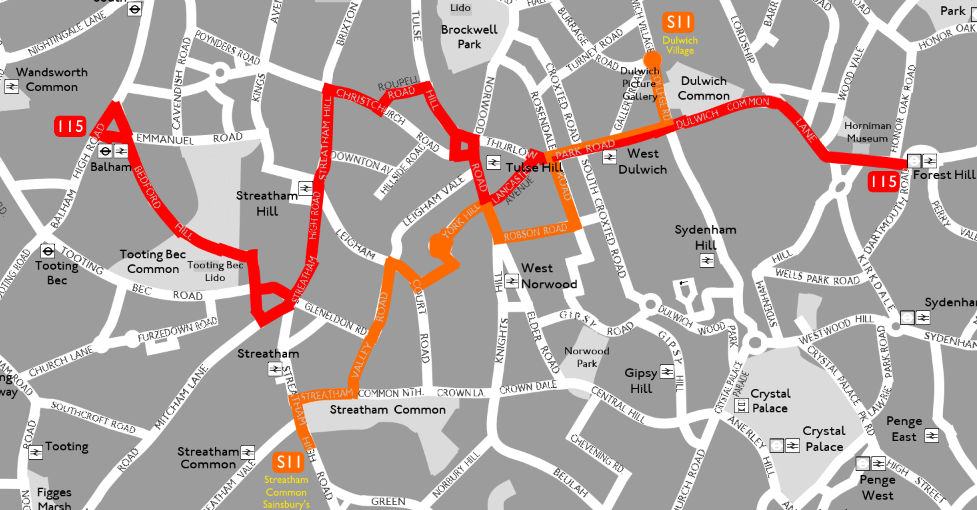 |
| 1990-1992 era London Buses 115 and Sainsbury's S11 |
The lack of S13 might be, puzzling to say the most. It isn't the 1990 map it stars in but only after 1992.
Why 1992?
 |
| The S13 |
I'm glad you've asked. It is the opening year of East Dulwich Sainsbury's, on the 24th March. It would sound bizarre nowadays that a supermarket would have bus routes of it's own sponsorship. Not outrageous when the bar to have a service was low, as well as the overlords of London Transport having put into gear that it's also a thing to have smaller buses in places big double deckers can't fit or people complained about them, ahem. Thus the first London Transport route a few months later in July to use the Sainsbury's became P2 (replaced by P13, extended from Peckham to Forest Hill Sydenham Rise in 1994) and since the only TfL route there until 2017 with the 42.
Coming back to the S13, it was simply a circular around the vicinity of the Sainsbury's, going anticlockwise along Dog Kennel Hill, Denmark Hill, Herne Hill, East Dulwich Grove to end up back at the Sainsbury's.
When looked at from an angle it's not bizarre the S11 appears in a 1990 map. Streatham Common Sainsbury's came into existence in the late 1980s in 1989 when a textile mill was turned into the shopping place where you bring your car to park at today. To say it's suitable as a non-car user is reaching it. It is far enough from the bus stops along Streatham High Road to be an inconvenience to frequent, and also narrow to walk into. Even narrow for cars to go side by side entering the place. So even by today's standards a midibus isn't fitting in, though your then-average Optare StarRider could, given they were literally vans with seats and a bus bodywork. I can't say with confidence it was a StarRider but it would definitely have been a breadvan of some description.
Unfortunately I can't confirm the frequency of either S11 nor S13 but what is certain is the restructure of both routes in the late 90s was that they already had more of a service than your average mobility route. This wouldn't make sense if serving roads used by other established services by a government-supported entity with an incentive to have a service at all.
However, S11 was the first route to use Valley Road and not the G1 (now 315), so it would be crude to leave the opportunity to make more patronage and thus money by leaving out a few arbitrary days of the week.
In timetables on the P15 the route is every 30 minutes, so this is a valid clue to assume. Assumptions however is no truth.
Patronage of the route was well on Saturday but not so much on Monday-Friday, but still well enough to keep the sections of S11 not paralleled by another service (so still east of West Norwood) though that would be what causes the decline that sees P15 withdrawn from West Norwood.
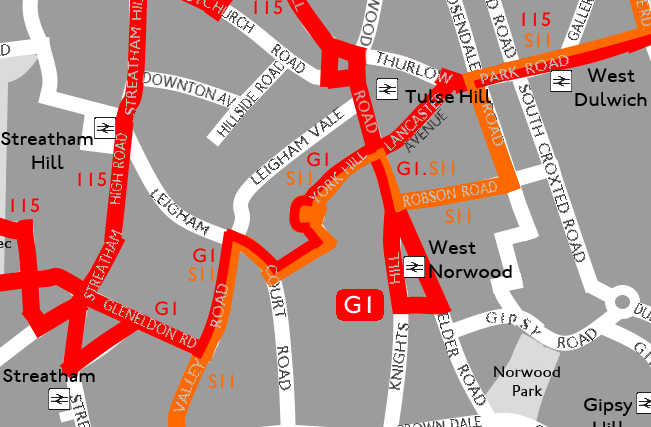 |
| G1 and S11 sharing |
Peckham (PM) would've operated S13 most likely as they had P15 which given it's comparable similarity to P13 whom is already operated from there, would make sharing the same pool of LDPs an easy task, even more so with P15 relegated to Saturday-only thus not requiring an extra bus drafted in. Even if I'm wrong Camberwell (Q) is the only other depot with small enough buses ready for the task.
To turn back to history. On 29 April 1995 the 115 is withdrawn, G1/P13 restructured, new routes 201 and 315 come into existence. This doesn't concern S11/S13 only that it parallels 315 instead of G1 now.
Enter summer of 1998.
The S11 and S13 are to be withdrawn. London Transport and Sainsbury's have already committed to keeping it one year later but that time has now expired. The solution is to ditch the section west of West Norwood since it's served by the 315 (every 20) whilst keeping the section east of it. The next is to combine the loop of S13 as a partial two-way function but keeping costs low. The route would be a circular not too dissimilar to the way our Woolwich 291 does.
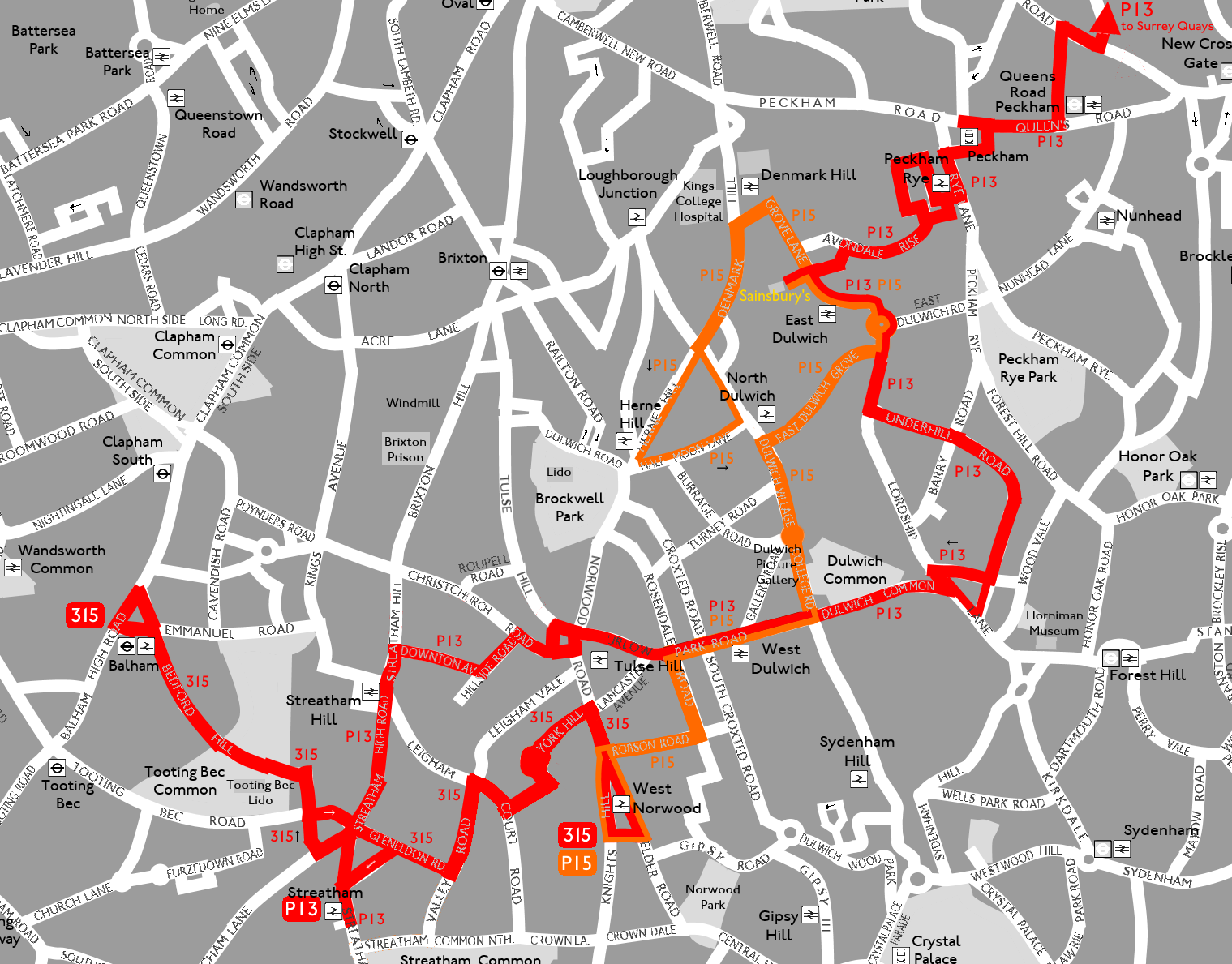 |
| Circular P15 and the now-TfL 315 and P13 |
Dulwich Village. An area that rejected the notion of double decker buses whilst having 37 as their fence-route, even full-time for a period in the late 90s with North Dulwich Station having bridge works done. The village has done something no other non-Dulwich neighbouring area would surely exercise the right to do; complain about loss of a service. Then MP Tessa Jowell writing to Mr Sainsbury personally.
However, the amalgamation of S11+S13 now known as P15 wouldn't last long in it's lessened form. It gets shortened in 2001 from West Norwood to Dulwich Village changing into a circular from East Dulwich Sainsbury's.
I'd say the bread and butter to withdrawing a service is making it look like it's weak, so killing it slowly would suffice well. A bit like the NHS's current state. In any case, the last time P15 ever saw breath was before Christmas 2004, of which it never saw the light of the day again.
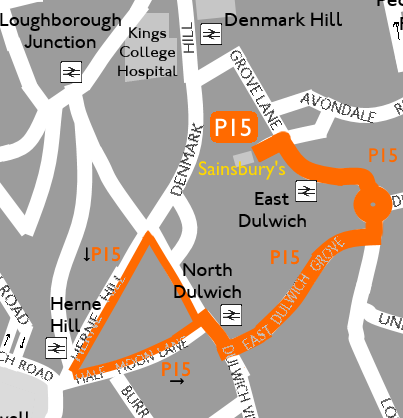 |
| Small P15 |
It can be inferred from this that, whilst unfortunate, the only roads unique to S11 was a section of Valley Road not served by 315 and a section of Rosendale Road not served by 322.
Furthermore, the P15 shadows the P13 as a slower version of the route, but linking Dulwich and Norwood even if only on Saturdays unlike the S11 which had an undescribed weekday service of some kind.
Whilst implied that S11/S13 was a collaboration of London Transport and Sainsbury's, it was, just like P15, nothing more than a shadow of the 315 and P13 with commercial status. A commercial status of being tendered by Sainsbury's, who could easily see fit to not have it continue, as has happened at Streatham Common Sainsbury's with S11 to the dismay of it's users.
------------------------------------------------------------------------------------------------------------
Now, hypothetically if this interesting specimen of P15 was realised into a London Transport Transport for London friendly revenue service, in what appearance could it have benefited the masses? Perhaps, not only locals to their nearby Sainsbury's, but some other places that guarantee demand.
New route: P15
For clarity's sake it might be fair to reintroduce the route under the Transport for London moniker and thus support. Though it does utilise roads with stops already present, it could very easily have used roads that never had bus services. Rosendale Road and Valley Road had/has invisible bus stops due to the our famed Hail & Ride system, with timetables in the case of 315.
Streatham Station - Valley Road - Leigham Vale - Norwood Road - Robson Road - Park Hall Road - Rosendale Road - Turney Road - Burbage Road - College Road - East Dulwich Grove - Grove Lane - East Dulwich Sainsbury's - King's College Hospital - Camberwell Green
An every 20 min route that interworks with the 315 providing an every 10 minute service along the popular West Norwood to Streatham link.
What it doesn't take a genius but a frequent to the area is that, yes, Valley Road is a traffic haven a lot of the time. Valley Road having 315 satisfies the Streatham link. Valley Road's unserved section in walking distance from 249 wouldn't satisfy much given the proximity of Streatham unless coming from afar but nonetheless is still a popular stop in it's own right. Whilst Leigham Vale does lose out a lot from having no service, not helped by being another parked car museum, however it is the road that gets you to Tulse Hill station. It is a gamble to say there is a need for a Valley Road to Tulse Hill link, but what is a certainty is that an every 20 minute 315 is stuck in the last century.
Furthermore, the P13 does exist for the East Dulwich link. What P13 and no other Streatham or West Dulwich route could provide is a Camberwell link. It's obviously indirect coming from Streatham but it gets more valuable as you get east of West Norwood (which has 68/468) as West Dulwich requires a change at Brockwell Park (Hopper makes changing a no-cost feature), whilst Dulwich Village has had the 42 in distance for a few years now. Streatham Wells (315/417's area) is under Lambeth and so is King's College Hospital.
Bottom line is, the addition of Camberwell as a traffic objective would spark life into it rather than being just a shopper's route.
PVR: 5
Conclusion: Decent but potentially costlier than demand (not as much as 497.)
There could be any number of new route ideas that spawn off the S11/S13/P15 mantra but I've tried to cater for the Dulwich Village part (serving unserved roads 3 used as a diversion as a getaway for not paralleling every stop on P4) whilst taking into account the loss of the West Dulwich-West Norwood round-the-corner link and lack of capacity on 315 which could be done in any number of alternative means, no wrong answer but there are efficiencies to be balanced. In my thumbnail at the top of the post I used Valleyfield Road and Cheviot Road which are more than 400m away from the 315 as well as parts equally far from both Leigham Court Road and Knights Hill, a perfect gap plugged.
Which neatly segues to:
Existing route modification.
Given the P15 has it's roots as a route that shadowed 315 and P13, we can focus on changing the existing routes.
Touching the P13 is out of question since the route functions very fine as it is. Low frequency timetable-wise but it's structure has lasted with good reason, linking Streatham and Peckham not at speed but acceptable pace with the dreaded South Circular Road.
Therefore the 315 is the next option, a little background is necessary.
It's always been every 20 since introduction in 1995, then gained a half hourly Sunday service in 2001, the frequencies haven't changed to this day. The route carried 711K passengers in 2010/11 whilst in 2019/20 it carried 556K passengers, a notable drop over the decade. Unfortunate as it is, it doesn't seem to have the demand to necessitate the cost of maintaining an every 15 minute service.
Low-cost: 315 to West Norwood, Rosendale
Traditionally the area sandwiched between West Norwood and West Dulwich's borders had a low frequency service, unless going further back nearer war-times when the previous 2 was very generous in service frequency compared to the combination of 2/13/82/415/432 today. That changed until the old 2 died in favour of minibus 322 with double the peak frequency: every 10 minutes. Peak frequency reduced to pay for it's extension from Vauxhall to Elephant. Yada yada the 322 became London's least reliable route, got low frequency again and now high frequency again.
Long story short: It's little, but it does provide a service that isn't already packed as further onward travel for existing 315 users, rather than benefitting a new pool of potential passengers.
Con: The moderately used West Norwood Station link would be the detriment to this cause.
Some paint would be needed on Myton Road stand...
As far as TfL are concerned Myton Road stand exists in functioning order for the 322 as a historical hand-me-down from the old 2 and routes before it as "West Norwood, Rosendale" (which apparently is now "West Norwood", God help my soul) but I can count on my hand the amount of days cars aren't parked on it in the year. To top it off, even making out of the stand isn't easy, again due to an abundance of parked cars.
No PVR increase required. Since the length of Robson Road is similar to the distance that Cheviot Road is to Norwood Road/Robson Road in time and physical length.
Higher cost extension: 315 to Forest Hill
An astute historian would see an undertale of nostalgia, since the 315 is the offshoot of 115 which was a horrible amalgamation of 201 and P13's Streatham-Tulse Hill sections and G1's Shaftesbury Estate section. As mentioned earlier this 115 had a brief stint terminating at Forest Hill at an every 30 minute frequency before cut back to Dulwich College during peak hours (Tulse Hill otherwise) with a loop working via Dulwich Village to stand outside the college. Forest Hill is close to the P4 and P13 but small dice, especially the P13 which isn't a stone's throw whereas the P4 is.
Whilst it was unfortunate the Streatham-Forest Hill link disappeared with 115's cutback, it being an indirect route and every 30 didn't help matters at all. Whilst currently the 315 is every 20, a lot better than half hourly but still a distant frequency for the majority. A bit like 384 which is also every 20 but extended from Barnet to Edgware, though the 384's patronage mostly came from 107/292 users.
A fair bit of patronage would come from Dulwich College, how much that fair bit equates to is uncertain, what is certain is walking from there to West Norwood isn't the end of time, above 15 minutes roughly.
PVR increase of +2 (every 20) [4 > 6]
+3 (every 15, interworked with P13 to provide every 7-8 corridor frequency) [6 > 9].
Journey time increase of 15-20 minutes.
An every 20 frequency might not be a good idea, given the P13 was a disastrous performer with that frequency, it's increase in frequency was on a budget so was less reliable until a robust schedule somewhere around contract renewal.
------------------------------------------------------------------------------------------
I've omitted the S13 discussion since the 42's extension from Sunray Avenue to East Dulwich Sainsbury's is largely similar and is also enough, in fairness it's received two frequency reductions since going double decker but it's not going to severely impact those that rely on it, just that those with more options will end up booking or jumping on their car, or other alternatives. Unlike most central routes the 42's outer section is relatively sombre in nature, as a sort of mobility route but it's a daily route. Getting to the hospital or getting to the local supermarket. In short: localised.
It's fine, it's a system that works well. Some patronage is better than no patronage. If you look at it in a different light however, it's big bus doing the work of small bus. Inefficient in nature, whilst you have lots of routes with smaller buses having heavy loads, almost at breaking point but not enough damage to draw immediate action, one that would require media reports or complaints to local MPs whom forward to relevant people in the space.
One thing can be done in light of this, shift the 42's mismatch dilemma to a single deck route in question, the 315, whilst making more use of 42's double deck status (though low frequency now at time of writing).
Rerouted extensions to routes 42 and 315
42 to Crystal Palace; 315 to Camberwell Green.
Croxted Road corridor which for the most part has only been the 3, though with the addition of route 201 north of West Dulwich to give the road a direct round the corner link to Tulse Hill which has and is lightly used, though more used compared to previous years. It takes only the few with an IQ nearer 200 or above to realise that the road, or corridor in lingo, has a popular demand to/from Brixton and to/from Crystal Palace, with usage at Herne Hill.
What it takes a local or a visitor to the area to realise is that there's a very healthy amount that switch at Brockwell Park for 68/468 whom would no doubt go Camberwell or even Elephant, it becoming a very favourable interchange northbound in 2010 when the bus stop known as Brockwell Park came into existence, look up Google Maps to find the stop didn't exist. I totally did not struggle when it first appeared with drivers not stopping there at all the first few weeks.
The case for an extra route along Croxted Road isn't a small one. Yes the 3 can suffice for demand to Brixton. Yes the 3 is frequent. No the 3 isn't the Lord and saviour when things go wrong since any diversion involves sending it via Tulse Hill and Central Hill.
It is fine if a route is operating at, say, 80% capacity or greater. Though at what point does it tip enough to find alternative means? Considering the 3's frequency was every 6 as the century turned, now it's every 8 with the combination of a single frequency cut in 2005 to source buses for 196's extension to replace 322's Elephant end and "temporary" roadworks to nudge it from every 7-8 to every 8.
I was of the opinion extending 201 could be viable but that is firmly something I believe against, given it's problems at the Morden end with traffic which isn't helped by lack of capacity coupled with a low frequency.
The perfect opportunity for an additional route would've been prior to 1994 when the 40 was still terminating at Herne Hill. It was rerouted to relieve the 176/185 whereas Herne Hill had Thameslink get it's act together so was fine enough to sacrifice.
Pros: Crystal Palace and Croxted Road receive a link to Camberwell for the first time
Milkwood Road regains a bus service (the 42 was cut back in 1966) thus relinking Herne Hill and Loughborough Junction
Part of Rosendale Road regains a bus service (P15 as we discussed was the last)
West Norwood and West Dulwich, Dulwich College, Dulwich Village relinked again
Burbage Road receives service for the first time
Cons: Denmark/Red Post Hills loses (indirect) round-the-corner link to East Dulwich Sainsbury's
The lack of linking Herne Hill to Burbage Road makes a 315 in that routeing dubious in potential
PVR increases;
Route 42: +4 [10 > 14]
Route 315: +3 [4 > 7]
Journey time increase of up to 30 mins (42) and up to 35 mins (315).
Rerouted extensions to routes 315 and 450
315 to Lower Sydenham Sainsbury's; 450 to Camberwell Green.
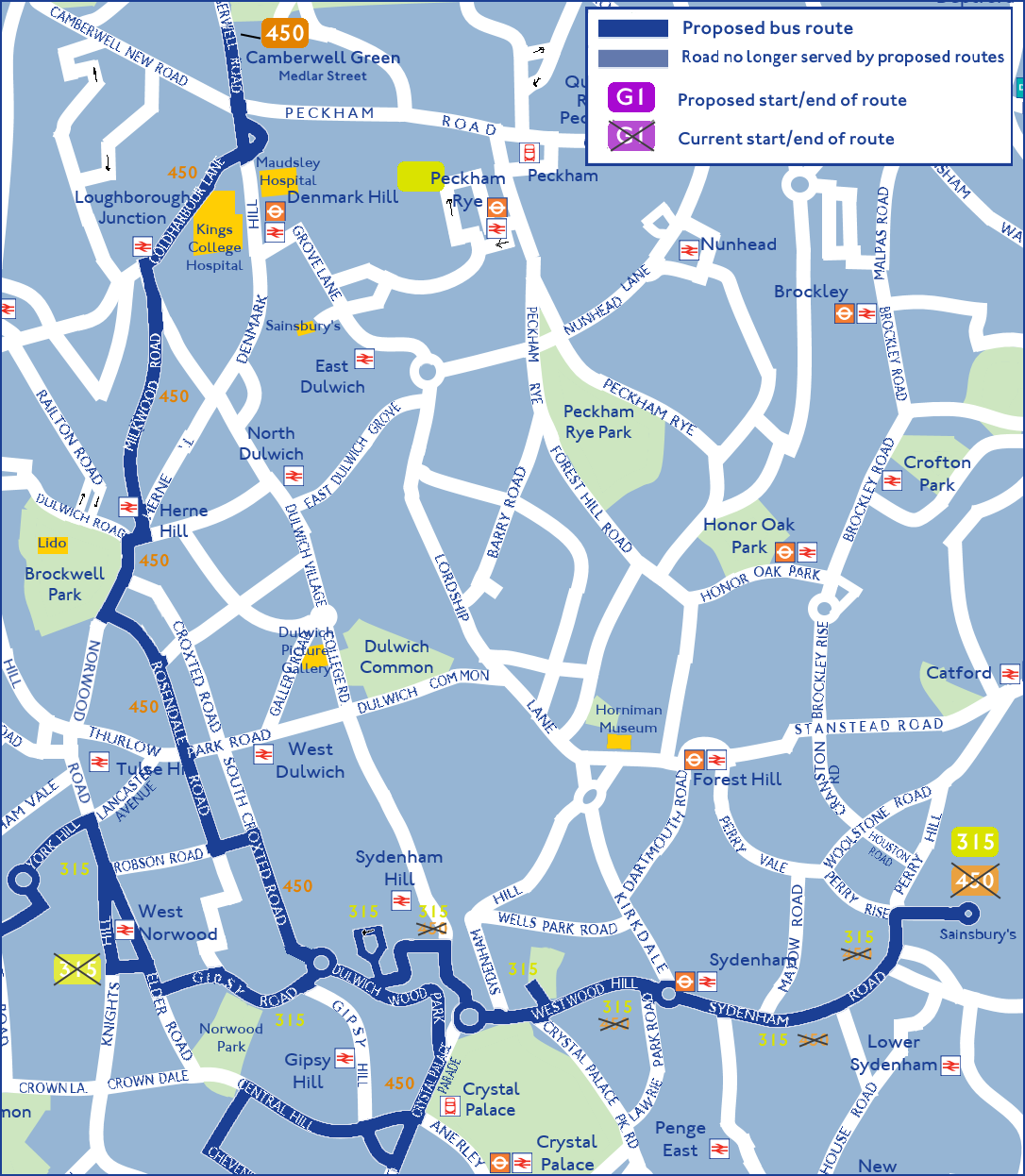 |
| Snippet from original image |
Yes I've already made my points clear in my Unorm Lambeth/Southwark review about this even if I've lumped 255/315/450/G1 in one bracket. What I haven't elaborated on since the focus wasn't the 450 was, the 450's own baggage. It's pinchpoints as listed in it's tender spec sheet is Crystal Palace Parade and Thornton Heath Station. Am I painting a picture yet? Continue. It's a route whose frequency kept increasing through every subsequent contract change since 2001 when it was every 15, until 2016 when it achieved an every 8 minute frequency, and it's Sunday frequency becoming every 15 whilst 15 years prior it only just received it.
To recap, it's an understatement to say the Croydon-Crystal Palace section is busy.
The same can't be applied for it's Crystal Palace-Lower Sydenham section, a hand-me-down from the old 306 (202 but via Westwood Hill) with the addition of unserved (by daily routes) Kingswood Drive whom has only been served by mobility route 931 whom provided the area with the Sainsbury's of Lower Sydenham as well as Tescos in Lewisham not to include the shopping centre of Lewisham itself. The 450 merely provided a daily service to the local supermarket and the interchange of Crystal Palace nearby.
A stroke of luck has gotten 450 to serve Lower Sydenham as the 306 wasn't meant to be replaced but the loss of the Lower Sydenham Sainsbury's link was cried for in no different fashion to Dulwich and S11/S13.
For the sake of the side streets of Upper Norwood and Thornton Heath, the section north of Crystal Palace has had an abundant service, I will not cry the word "overbus" like a wolf, silly me!
Instead what I will say is that if tomorrow the 450 was rerouted as per the picture you see to the right, it would guaranteed require another frequency increase, and 450 is already in the top 10 busiest single deck routes (2019/20 data so skewed from pandemic but still) which is a blessing and a curse, a double-edged sword. In terms of more accurate data, in 2019/20 it carried 3.7 million and in 2010/11 it carried 2.7 million.
PVR increases: route 315: +8 (every 15) to 12.
route 450: +0 (every 8) to 19.
An alternative to the lack of Crystal Palace round-the-corner link could be solved by just having 450 go down the loop in the opposite direction which will definitely cause confusion but life is life, you live and learn. An alternative would be rerouting 356 the opposite direction on Sydenham Hill, down Fountain Road and looping as 450 does now, which might add an extra bus but it's every 20 anyway, and has it's own crippling issues as it stands, a bit like 315 but elevated an extra step.
Speaking of 315, a duo of 315/356 would bring in more links than I envisaged as I literally write this, Forest Hill which required a switch to 122, Elmers End but at that stage 356 has gotten indirect.
------------------------------------------------------------------------------------------
 |
| It's just a 42 on South Croxted Road |
The common theme with this really has been a West Norwood-West Dulwich link, which is walkable, or an annoying crush load to a 322 and then walk, which is stupid in hindsight. The other theme being 315's issue of frequency and capacity not being fit.
A revealing detail I overlooked whilst researching was the 1995 map detailing 322's use of Myton Road which was used for the stand there, presumably as a bus stop, but the use of Myton and Martell Roads dropped for the more convenient and simply left turn from Rosendale Road to Park Hall Road rather than involving two extra turns.
It was fun looking through Sainsbury's archives and piecing together the puzzle pieces of history, going by two editions of maps and a few sentences in a paragraph in the articles linked below. Thereafter recreating the old in the 21st century and expanding it outside Sainsbury's as a shopping objective but other places of interest.
I hope you too enjoyed this whacky tale with a bunch of maps plastered over your face, and hope to see you in the next one, until then, stay safe!
Article 3: Shopper's bus only runs on Saturdays
.
Fun facts: Herne Hill Velodrome hosted for the Olympics in 1908 and 1948.

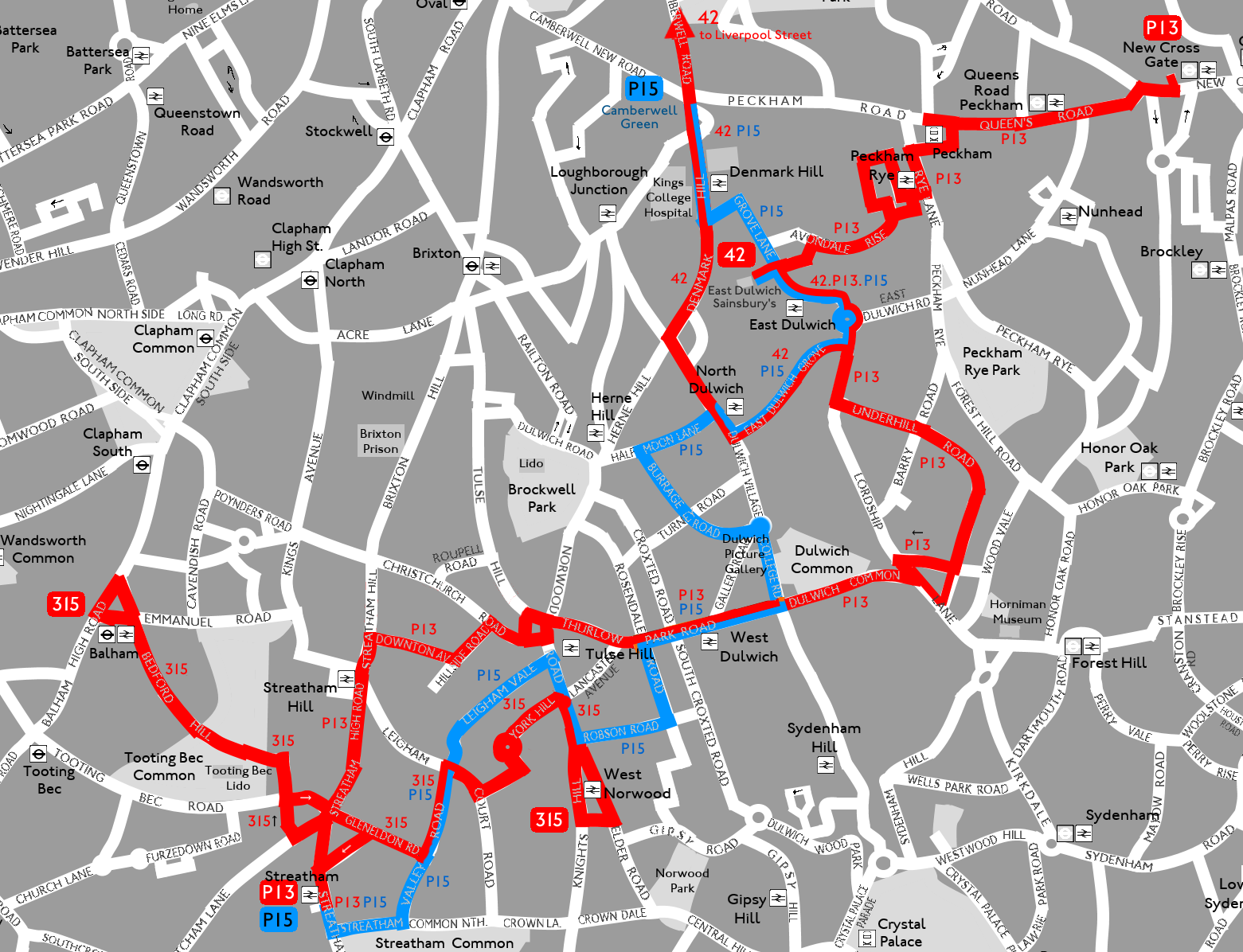



No comments:
Post a Comment